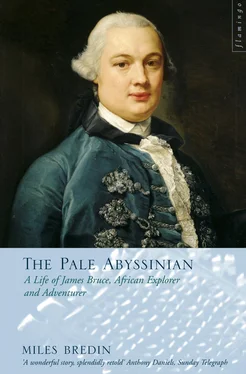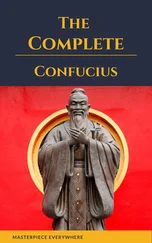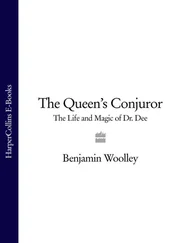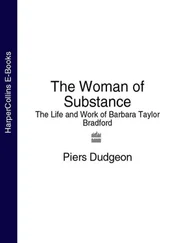Halifax’s principal wish, claimed Bruce, was ‘that I should be the first, in the reign just now beginning [George III had become King in 1760], to set an example of making large additions to the royal collection, and he pledged himself to be my loyal supporter and patron, and to make good to me, upon this additional merit, the promises which had been held forth to me by former ministers for other services.’ (Bruce claims to have been offered a baronetcy and a pension for his plan to attack Ferrol. There is no record of this but it would have been a perfectly natural offer.) He continued:
The discovery of the source of the Nile was also a subject of these conversations; but it was always mentioned to me with a kind of diffidence, as if to be expected only from a more experienced traveller. Whether this was but another way of exciting me to the attempt I shall not say; but my heart in that instant did me the justice to suggest, that this, too, was either to be atchieved [sic] by me, or to remain, as it had done for the last two thousand years, a defiance to all travellers, and an opprobrium to geography.
The deal struck, Bruce headed back to Scotland with a new spring in his step. He was at last a man with a purpose. But he must first settle his affairs. The estate had to be put into the hands of lawyers and factors, the bank must arrange for him to be able to draw money in Cairo and other points east and he must prepare himself for what was destined to be a long journey. On 18 February 1762, he received official notice from Robert Wood that the consulship was his, and moreover, Wood had managed to arrange matters such that Bruce would be able to spend time in Italy on the way. There he would finish his artistic education in order that he might be able better to appreciate the antiquities of the ancient world.
At the age of thirty-two Bruce’s professional life had at last come together. His love-life followed suit: he had fallen head over heels for a sixteen-year-old neighbour – Margaret Murray – who promised to wait for him whilst he was in foreign parts. (We know nothing of his relationships with women between the death of his first wife and his engagement to Margaret. He never wrote about this period, but judging by his later behaviour we can presume that he had mistresses and women friends.) Prepared and cocksure in both his private and public lives, he went to London where he was presented at court and given details of the task that awaited him.
The king had, in fact, initially objected to Bruce’s appointment. With the good sense which he would retain, for the most part, until much later in his reign, he had ventured to Halifax that it might be wiser to appoint a consul who knew something of the Barbary States. It was true that Bruce spoke Arabic, an unusual accomplishment, but since none of his predecessors had done so, and all consuls were provided with an interpreter, this was not seen as an advantage. Other than this, Bruce had no qualifications for the job. The appointment was, and was intended to be, a sinecure. Wood, though, had not only the ear of the prime minister, but also that of the king. Only two years later he would be made Groom Porter to the Royal Household, a role which had nothing to do with brushing or carrying and everything to do with influence. Already, in 1762, he was in a position to calm the king’s anxieties and ensure that his protégé was well-received. In April Bruce, by then ‘a man of Herculean physique and more than ordinary strength of mind’ (according to Nimmo in his History of Stirlingshire), left Britain for France. It would be twelve years before he returned.
In his baggage he had hundreds of books and instruments to which he would add on his travels. Ludolf’s History of Ethiopia would have been near the top of the pile with Herodotus, Cosmas Indicoplustes and his mentor Wood’s 1753 publication The Ruins of Palmyra. These would come to a sad end in Cairo:
To reduce the bulk as much as possible, after considering in my mind what were likeliest to be of service to me in the countries through which I was passing, and the several enquiries I was to make, I fell, with some remorse, upon garbling my library, tore out all the leaves which I had marked for my purpose, destroyed some editions of very rare books, rolling up the needful parts, and tying them by themselves. I thus reduced my library to a more compact form.
Bruce had measuring rods, three telescopes from François Watkins in Charing Cross, another made for Edward Wortley Montagu by Adam, quadrants and charts of the stars so he could use them correctly. (Edward Wortley Montagu, the supremely eccentric son of Lady Mary and a later critic of Bruce, had been unable to collect his telescope for at the time he was penniless in Italy, reeling from the news that his mother, who had just died, had left him only a guinea in her will.) Bruce was extremely interested in astronomy but would also be using the equipment for navigational and charting purposes. He did not merely wish to discover the source of the Nile; he wanted to put it on the map. The telescopes had been troublesome to obtain since all the worlds’s astronomers were preparing for the transit of Venus expected in June 1769. Captain Cook and Joseph Banks had set off to view it from the South Seas and their European counterparts were preparing to go to Armenia where it was expected to be especially visible. Bruce also wanted to see the phenomenon but was not sure where he would do so. He had guns aplenty with which to fight and bribe his way around Africa. Most came from Heriot Row – some ‘silver mounted and richly wrought’, others, like the three ships’ blunderbusses, more practical than attractive. He had snuff boxes and shoes from London, ammunition and swords, wine and cutlery and £66 worth of new clothes from one shop alone. He was as well-prepared as Evelyn Waugh’s William Boot in Scoop in all but one respect: he had no cleft sticks, for it was Bruce who discovered that they are used in the Ethiopian highlands by message bearers.
The putative consul had managed to receive permission to travel through France despite it being the sixth year of the Seven Years War. None the less, fuelled by pride in his new office, he rushed directly to Rome to receive his orders. The king had given him a mission in Malta so Bruce was able to visit Italy rather than embark immediately for the Barbary States. King George believed himself to have been slighted by the Catholic Grand Master of the chivalric island state, who had been far too friendly to the French. Knowing that diplomacy moves slowly, Wood had already arranged that Bruce should deliver the ultimatum, before it had even been decided upon, let alone written. When it was completed it would be delivered by warship to Bruce in Italy. Wood’s purpose was to allow Bruce time in Italy to learn about antiquities. Neither of them, however, realized quite how long the visit would be. Bruce eventually had to kill time for eight months before he continued on his way, a period that he spent profitably, improving his mind and making contact with people who would later be of assistance.
In Rome Bruce studied the paintings and sculptures in the Vatican and in the houses of the fashionable set. Doubtless, he was inspired by his surroundings as he walked around the ancient capital which, millennia earlier, had sent out its own adventurers to seek the head of the Nile. Writing only two years before Bruce’s arrival, the German art historian and resident of Rome, Johann Winckelmann, had said of Bernini’s Fountain of the Four Rivers:
The unknown sources of the Nile are ingeniously represented in the figure of this river on the fountain in the Piazza Navona in Rome by a garment with which he seems to be trying to conceal his head. This symbol is still true today, for the sources of the Nile still have not been discovered.
Читать дальше











